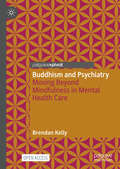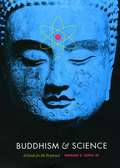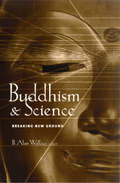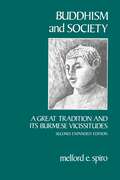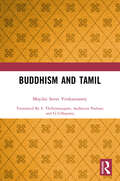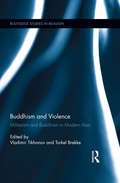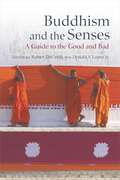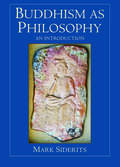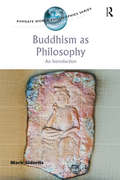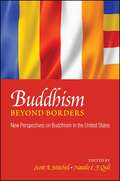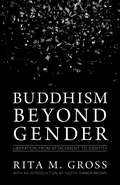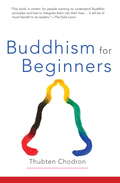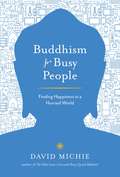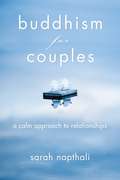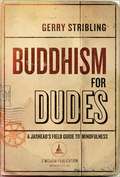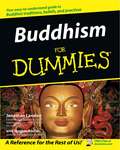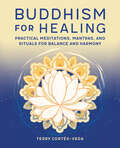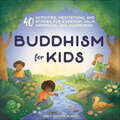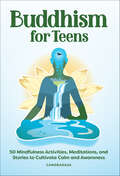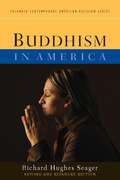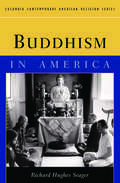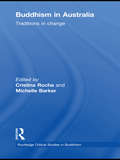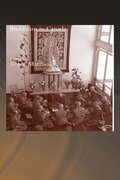- Table View
- List View
Buddhism and Psychiatry: Moving Beyond Mindfulness in Mental Health Care
by Brendan KellyThis Open Access book explores the emergence of mindfulness from Buddhist tradition and its incorporation into contemporary mental health and social care. Mindfulness is a powerful technique, but it needs to be applied mindfully. Buddhist thought has older links with psychiatry and mental health care, prior to the current embrace of mindfulness, and these have not been articulated clearly over recent decades. These links are intrinsically valuable and have added relevance in an era of mindfulness. This book seeks to bring these associations and connections back to light and contextualise recent enthusiasm for mindfulness-based interventions. This book is aimed at readers who are interested in mental health, psychiatry, Buddhism, and mindfulness. These are all growing areas of interest and inquiry. This book is distinctive owing to its focus on links between psychiatry, mental health care, and Buddhism that include, but also move beyond, mindfulness. This book is also distinctive by virtue of the fact that it is written by someone who is both a psychiatrist in clinical practice and a researcher, as well as being qualified in Buddhist Studies (MA, University of Sunderland, 2010) and Mindfulness-Based Interventions (MSc, University College Dublin, 2023), and publishes across all of these fields.
Buddhism and Science: A Guide for the Perplexed
by Donald S. LopezBeginning in the nineteenth century and continuing to the present day, both Buddhists and admirers of Buddhism have proclaimed the compatibility of Buddhism and science. In "Buddhism and Science", Donald S. Lopez Jr. is less interested in evaluating the accuracy of such claims than in exploring how and why these two seemingly disparate modes of understanding, the inner and outer universes, have been so persistently linked.
Buddhism and Science: Breaking New Ground (Columbia Series in Science and Religion)
by Alan WallaceBuddhism and Science brings together distinguished philosophers, Buddhist scholars, physicists, and cognitive scientists to examine the contrasts and connections between the worlds of Western science and Eastern spirituality. This compilation was inspired by a suggestion made by His Holiness the Dalai Lama, himself one of the contributors, after one of a series of cross-cultural scientific dialogues in Dharamsala, India, sponsored by the Mind and Life Institute. Other contributors such as William L. Ames, Matthieu Ricard, and Stephen LaBerge assess not only the fruits of inquiry from East and West but also shed light on the underlying assumptions of these disparate worldviews. Their essays creatively address a broad range of topics: from quantum theory's surprising affinities with the Buddhist concept of emptiness, to the increasing need in the West for a more contemplative science attuned to the first-person investigation of the mind, to the important ways in which the psychological study of "lucid dreaming" maps similar terrain to the cultivation of the Tibetan Buddhist discipline of dream yoga. Reflecting its wide variety of topics, Buddhism and Science is comprised of three sections. The first presents two historical overviews of the engagements between Buddhism and modern science or, rather, how Buddhism and modern science have defined, rivaled, or complemented one another. The second describes the ways Buddhism and the cognitive sciences inform each other; the third addresses points of intersection between Buddhism and the physical sciences. On the broadest level this work illuminates how different ways of exploring the nature of human identity, the mind, and the universe at large can enrich and enlighten one another.
Buddhism and Society: A Great Tradition and Its Burmese Vicissitudes
by Melford E. SpiroThe current Western interest in Buddhism and other Eastern religions is--among other reasons--both the result of and the stimulation for an entire library of books purporting to bring the Wisdom of the East to an audience for whom the wisdom of the West has failed. This book is not an example of that genre. It is an attempt to interpret Buddhism in the light of some current theories about religion. As a work of scholarship, rather than a homiletic tract or an apologetic treatise, its aim is to understand Buddhism as one historical variant of the generic human attempt to find meaning and hope in a sacred order that transcends the mundane order of existence; its aime is not to encourage or discourage either a devotional or a soteriological interest in Buddhism.
Buddhism and Tamil
by Mayilai Seeni VenkatasamyFirst published in 1940, Mayilai Seeni Venkatasamy’s Buddhism and Tamil was one of the pioneering attempts to trace the history of Buddhism in the Tamil country. With judicious exploitation of archaeological, linguistic, and historical sources, Venkatasamy delineates how Buddhism flourished from the 2nd century BCE to the 13th century CE and traces its residual presence in contemporary Tamil culture. The book challenges the then-prevalent belief that Tamil is synonymous with Saivism and problematises the simplistic understanding that Hinduism had always been the religion of India. Venkatasamy’s stylistic and literary analysis of Pali and Tamil texts, his careful study of inscriptions, and his extensive fieldwork identify the role of Buddhism in shaping the language, literature, and ethics of Tamil society.
Buddhism and Violence: Militarism and Buddhism in Modern Asia (Routledge Studies in Religion #19)
by Torkel Brekke Vladimir TikhonovIt is generally accepted in the West that Buddhism is a ‘peaceful’ religion. The Western public tends to assume that the doctrinal rejection of violence in Buddhism would make Buddhist pacifists, and often expects Buddhist societies or individual Asian Buddhists to conform to the modern Western standards of ‘peaceful’ behavior. This stereotype – which may well be termed ‘positive Orientalism,’ since it is based on assumption that an ‘Oriental’ religion would be more faithful to its original non-violent teachings than Western Christianity – has been periodically challenged by enthusiastic acquiescence by monastic Buddhism to the most brutal sorts of warfare. This volume demolishes this stereotype, and produces instead a coherent, nuanced account on the modern Buddhist attitudes towards violence and warfare, which take into consideration both doctrinal logic of Buddhism and the socio-political situation in Asian Buddhist societies. The chapters in this book offer a deeper analysis of ‘Buddhist militarism’ and Buddhist attitudes towards violence than previous volumes, grounded in an awareness of Buddhist doctrines and the recent history of nationalism, as well as the role Buddhism plays in constructions of national identity. The international team of contributors includes scholars from Thailand, Japan, and Korea.
Buddhism and the Senses: A Guide to the Good and Bad
by Donald S. Lopez Jr. Robert DeCroliAcross Buddhist traditions, the five senses—sight, sound, smell, taste, and touch—are perceived both positively and negatively. Share our eminent scholars&’ fascination and deep insight into what makes a sensuous experience good or bad.Following on the exhibition Encountering the Buddha: Art and Practice across Asia at the National Museum of Asian Art, ten eminent scholars present their insights into Buddhism&’s fascinating relation with the five senses (sight, sound, smell, taste, and touch), which careens between delight and disgust, rarely finding a middle way. While much of Buddhist literature is devoted to overcoming the attachment that dooms us to rebirth in samsara, primarily by deprecating sense experience and showing that whatever brings us sensual pleasure leads only to physical and mental pain, in texts such as the Lotus Sutra, sensory powers do not offer sensory pleasure but rather knowledge, clear observation, and ability to teach the Dharma. Considering such religiously and historically contingent ambiguity, this volume presents each of the five senses in two instantiations, the good and the bad, opening up the discourse on the senses across Buddhist traditions. Just as the museum departed from tradition to incorporate sensory experiences into the exhibition, this volume is a new direction in scholarship to humanize Buddhist studies by foregrounding sensory experience and practice, inviting the reader to think about the senses in a focused manner and shifting our understanding of Buddhism from the conceptual to the material or practical, from the idealized to the human, from the abstract to the grounded, from the mind to the body.
Buddhism as Philosophy: An Introduction
by Mark SideritsIn this clear, concise account, Siderits makes the Buddhist tradition accessible to a Western audience, offering generous selections from the canonical Buddhist texts and providing an engaging, analytical introduction to the basic tenets of Buddhist thought.
Buddhism as Philosophy: An Introduction
by Mark SideritsThere has been a recent upsurge in interest in Buddhist philosophy, but there is as yet no satisfactory text on the subject. Buddhism as Philosophy fills that void. Unlike other texts that serve to introduce Buddhist thought, it is written by a philosopher and it shows how the Buddhist tradition deals with the same sorts of problems that get treated in Western philosophy and employs the same sorts of methods. This book does more than just report what Buddhist philosophers said; it presents the arguments of the Buddhist philosophers, in their own words, and it invites the reader to assess their overall cogency. In short, Buddhism as Philosophy investigates the Buddhist tradition by way of the characteristically philosophical concern for finding out the truth about complicated matters in metaphysics, epistemology and ethics.
Buddhism beyond Borders: New Perspectives on Buddhism in the United States (SUNY series in Buddhism and American Culture)
by Scott A. Mitchell; Natalie E. F. QuliFinalist for the 2015 ForeWord INDIEFAB Book of the Year Award in the Religion CategoryBuddhism beyond Borders provides a fresh consideration of Buddhism in the American context. It includes both theoretical discussions and case studies to highlight the tension between studies that locate Buddhist communities in regionally specific areas and those that highlight the translocal nature of an increasingly interconnected world. Whereas previous examinations of Buddhism in North America have assumed a more or less essentialized and homogeneous "American" culture, the essays in this volume offer a corrective, situating American Buddhist groups within the framework of globalized cultural flows, while exploring the effects of local forces. Contributors examine regionalism within American Buddhisms, Buddhist identity and ethnicity as academic typologies, Buddhist modernities, the secularization and hybridization of Buddhism, Buddhist fiction, and Buddhist controversies involving the Internet, among other issues.
Buddhism beyond Gender: Liberation from Attachment to Identity
by Rita M. Gross Judith Simmer-BrownA bold and provocative work from the late preeminent feminist scholar, which challenges men and women alike to free themselves from attachment to gender. At the heart of Buddhism is the notion of egolessness—“forgetting the self”—as the path to awakening. In fact, attachment to views of any kind only leads to more suffering for ourselves and others. And what has a greater hold on people’s imaginations or limits them more, asks Rita Gross, than ideas about biological sex and what she calls “the prison of gender roles”? Yet if clinging to gender identity does, indeed, create obstacles for us, why does the prison of gender roles remain so inescapable? Gross uses the lenses of Buddhist philosophy to deconstruct the powerful concept of gender and its impact on our lives. In revealing the inadequacies involved in clinging to gender identity, she illuminates the suffering that results from clinging to any kind of identity at all.
Buddhism for Beginners
by Thubten ChodronThis book is written for people wanting to understand basic Buddhist principles and how to integrate them into their lives. . . it will be of much benefit to its readers. --the Dalai Lama
Buddhism for Busy People: Finding Happiness in a Hurried World
by David MichieIn this simple and accessible but beautifully written book, David Michie opens the door to the core teachings of Tibetan Buddhism, and shows us how he himself first began incorporating Buddhist practices into his daily life.What does it take to be happy? We've all asked ourselves this question at some point, but few of us have found the path to lasting fulfillment. David Michie thought he had achieved his life's goals--the high-level job, the expensive city apartment, the luxury car, the great vacations--but a small voice was telling him he wasn't really happy. A chance remark from a naturopath sent him to his local Buddhist center. There he began the most important journey of his life. In Buddhism for Busy People Michie explains how he came to understand the difference between the temporary pleasures of ordinary life and the profound sense of well-being and heartfelt serenity that comes from connecting with our inner nature.
Buddhism for Couples
by Sarah NapthaliLearn Buddhist principles that can help enrich your romantic life, your life in general, and the lives of those around you.Surely a happy marriage for a normally adjusted couple is a simple matter of give-and-take--some patience, tolerance, and just trying to be cheerful as often as possible. There is no shortage of books providing relationship advice that can help us with these matters. But Buddhist teachings address more than just surface knowledge, and guide us to delve deeper into our psyches.With an emphasis on self-compassion, Buddhism for Couples explains how to apply Buddhist teachings to your relationships to patch things up, hold things together, and, even on good days, scale the heights of relationship happiness. Written for both men and women, this book tackles the loaded subjects of housework, anger, sex, conflict, and infidelity, and introduces Buddhist strategies that can enrich a relationship.Humorous and informative, Buddhism for Couples provides a fresh approach to living as a couple, persuading us to leave behind stale, habitual ways of relating that don't work.From the Trade Paperback edition.
Buddhism for Dudes
by Gerry StriblingA tough former Marine leads Buddhist basic training for the average Joe.In Buddhism for Dudes, Gerry "Strib" Stribling, former Marine and all-around good guy, answers questions on life and living with a healthy dose of Buddhist wisdom for the regular guy. Strib takes a good look at who the Buddha was, meditation, karma, and more. With good humor and without sentimentalism, he explains these down-to-earth insights in everyday language. Showing how Buddhism boldly approaches life's problems head on, unflinching and alert--like a soldier in a forward listening post in the dark of night--Strib emphasizes the Buddhist call to moral action for the good of oneself and others.
Buddhism for Dummies
by Jonathan Landaw Stephan BodianExplore the fascinating history of Buddhism. What's the significance of Buddha? How can the practice of Buddhism enrich your everyday life?
Buddhism for Healing: Practical Meditations, Mantras, and Rituals for Balance and Harmony
by Terry Cortés-VegaLearn to heal your heart and soul through Buddhism Discover a greater sense of peace, strength, and happiness through the healing possibilities of Buddhism. Filled with straightforward guidance and simple explanations of Buddhist beliefs and concepts, Buddhism for Healing teaches you accessible and effective ways to heal from stress, anxiety, and deeper feelings of loss. Beginning with fundamental Buddhism traditions and progressing to step-by-step meditations, rituals, mantras, and prayers, this beginner-friendly guide provides you with everything you need to start healing. Whether you're easing stress through easy yoga poses or achieving calm in the moment with mindfulness, you will find ways to achieve a greater sense of peace and serenity no matter what challenges you face now or in the future. Buddhism for Healing features: Healing meditations—Learn how meditation can help you better understand yourself and foster a healing mindset as you come to know your vulnerabilities and your strengths. Beginner-friend guidance—Whether you're familiar with Buddhism or just curious, you'll discover explanations and ways to encourage healing that are easy-to-understand and implement. A focused approach—Explore chapters dedicated to helping address specific concerns, like healing from grief, becoming more contented, and fostering compassion for yourself and others. A true feeling of peace is achievable—let Buddhism for Healing show you the way.
Buddhism for Kids: 40 Activities, Meditations, and Stories for Everyday Calm, Happiness, and Awareness
by Emily Griffith BurkeEasy and fun everyday Buddhism activities for kids ages 2 to 8Growing up can be hard, with lots of big changes and confusing feelings—but practicing Buddhism can help turn that confusion into curiosity and excitement about the world and our place in it. Using easy-to-follow meditations for kids, interactive activities, and vivid retellings of classic Buddhist stories, Buddhism for Kids brings the Dharma, or Buddhist teachings, to kids. Buddhism for Kids makes the practice fun and interactive.Organized by time of day—morning, day, and night—the book is designed to meet your little one's energy level, or wind them down for bed. Kids will learn how to check in with nature by greeting trees, express their feelings by drawing monsters, show kindness through a surprise gift, and apply the lessons learned through incredible stories to their own life.Buddhism for Kids includes:Dharma play—Watch your kids bring the teachings to life any time of the day through fun games and creative activities.Stepping stones—Find calm for the body, mind, and spirit with unique meditations your kids can do before school, during the day, or right before bed.Anytime story—Discover imaginative, illustrated retellings of classic Buddhist stories— each including a short moral to reflect on.Make your own spiritual path with Buddhism for Kids, the kid-friendly guide to everyday peace of mind.
Buddhism for Meat Eaters: Simple Wisdom for a Kinder World
by Josephine MoonFor many years Josephine Moon struggled with the question of eating meat, fervently wishing to live as a vegetarian yet requiring meat in her diet. From Josephine’s philosophical, spiritual and physical battle with eating meat came, Buddhism for Meat Eaters – a book for animal lovers, the environmentally and ethically conscious, and generally thoughtful people who eat meat but perhaps aren’t entirely comfortable doing so. Open, honest and utterly without judgement, Buddhism for Meat Eaters encourages readers to be more mindful about their choices, rather than berating themselves for them, and offers ways for people to live ethically, honestly and guilt-free, whether as a carnivore, vegetarian or vegan. This highly practical guide also includes workbook-style activities and topics for consideration to guide you in your own journey to making wiser decisions on how you consume, how you live, and how to change the world around you.
Buddhism for Teens: 50 Mindfulness Activities, Meditations, and Stories to Cultivate Calm and Awareness
by CanradasaHelp teens find their way to inner peace with Buddhist teachings It's not always easy for teens to navigate their lives at home, at school, and with friends, but through Buddhist meditation and mindfulness practices they can discover a path to inner calm and awareness. Buddhism for Teens introduces curious teens to the Buddhist way of seeing things and helps them build their emotional strength, their sense of self, and their connection to the world around them.What sets this Buddhism guide apart: Learning through action—There's no long-winded introduction to Buddhism here; teens can jump straight into immersive stories and activities that will change the way they look at life.Meditation made simple—Teens will find simple meditations to help them explore Buddhist concepts like joy, balance, and starting a new journey.Buddhism for beginners—This book is designed to be friendly to young newcomers, meaning teens can read from cover to cover or just choose the sections that resonate with them the most.Teens can experience the peace and balance of Buddhism with this enlightening guide made just for them.
Buddhism in Action
by Daisaku IkedaThis book is about Buddhism written by Daisaku Ikeda, who is the president of the Soka Gakkai International, one of the largest Buddhist cultural organizations in the world.
Buddhism in America (Columbia Contemporary American Religion Ser.)
by Richard Hughes SeagerOver the past half century in America, Buddhism has grown from a transplanted philosophy to a full-fledged religious movement, rich in its own practices, leaders, adherents, and institutions. Long favored as an essential guide to this history, Buddhism in America covers the three major groups that shape the tradition—an emerging Asian immigrant population, native-born converts, and old-line Asian American Buddhists—and their distinct, yet spiritually connected efforts to remake Buddhism in a Western context. This edition updates existing text and adds three new essays on contemporary developments in American Buddhism, particularly the aging of the baby boom population and its effect on American Buddhism's modern character. New material includes revised information on the full range of communities profiled in the first edition; an added study of a second generation of young, Euro-American leaders and teachers; an accessible look at the increasing importance of meditation and neurobiological research; and a provocative consideration of the mindfulness movement in American culture. The volume maintains its detailed account of South and East Asian influences on American Buddhist practices, as well as instances of interreligious dialogue, socially activist Buddhism, and complex gender roles within the community. Introductory chapters describe Buddhism's arrival in America with the nineteenth-century transcendentalists and rapid spread with the Beat poets of the 1950s. The volume now concludes with a frank assessment of the challenges and prospects of American Buddhism in the twenty-first century.
Buddhism in America (Columbia Contemporary American Religion Series)
by Richard Hughes SeagerBuddhism has influenced American culture since the American Transcendentalist movement in the 1830s and '40s; only recntly, however, has this transplanted philosophy begun to blossom into a full-fledged American religion. Seager offers a perceptive and engaging portrait of the communities, institutions, practices, and individuals that are integral to the contemporary Buddhist landscape, including six profiles of Buddhist traditions exported to the United States from Japan, Tibet, Southeast Asia, and elsewhere. The book also considers Americanization and recent developments in gender equity, progressive social change, and intra-Buddhist and interreligious dialogue.
Buddhism in Australia: Traditions in Change (Routledge Critical Studies in Buddhism)
by Cristina RochaThe number of Buddhists in Australia has grown dramatically in recent years. In 2006, Buddhists accounted for 2.1 per cent of Australia's population, almost doubling the 1996 figures, and making it the fastest growing religion in the country. This book analyses the arrival and localisation of Buddhism in Australia in the context of the globalisation of Buddhism. Australia's close geographical proximity to Asia has encouraged an intense flow of people, ideas, practices and commodities from its neighbouring countries, while at the same time allowing the development of the religion to be somewhat different to its growth in other Western countries. The book seeks to explore the Buddhist experience in Australia, looking at the similarities and particularities of this experience in relation to other Western countries. The inception of Buddhism in Australia is investigated, and a voice is provided to people on the ground who have been fundamental in making this process possible. For the first time, academic analysis and practitioners' experience are juxtaposed to show the adaptations and challenges of Buddhism in Australia from above and below. This book is a unique and valuable contribution to the study of Buddhism in the West, globalization of religion, and studies in Asian Religion.
Buddhism in Canada (Routledge Critical Studies in Buddhism)
by Bruce MatthewsBuddhism has become a major religion in Canada over the last half-century. The 'ethnic Buddhism' associated with immigrant Asian people is the most important aspect, but there is also a growing constituency of Euro-Canadian Buddhists seriously interested in the faith. This insightful study analyzes the phenomenon of Buddhism in Canada from a regional perspective. The work provides an important examination of the place of Buddhism in a developed western country associated with a traditional Judeo-Christian culture, but undergoing profound sociological transformation due to large-scale immigration and religio-cultural pluralism. It is a valuable text for students of religion, Buddhism and North American Studies.
